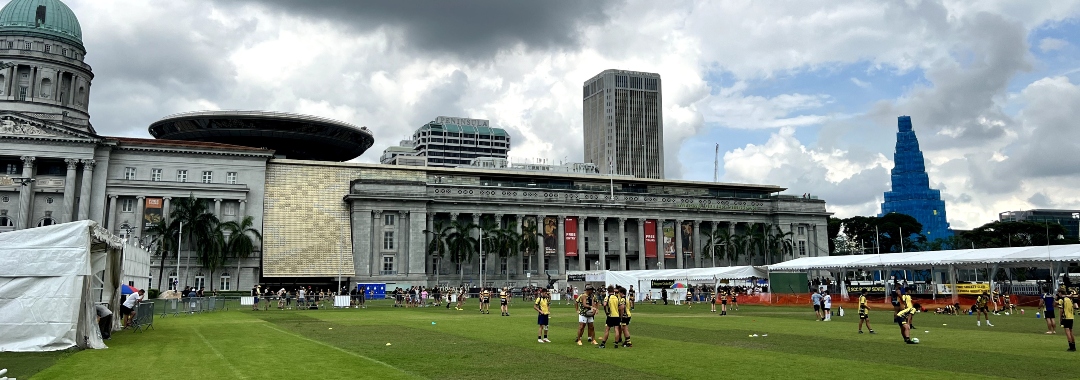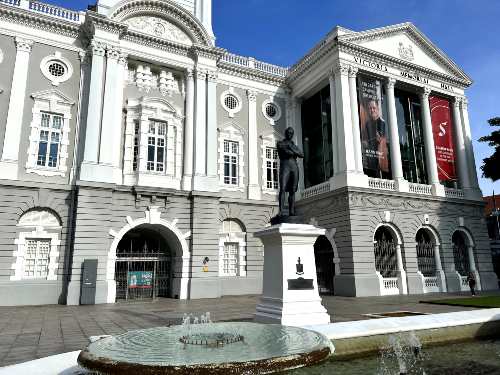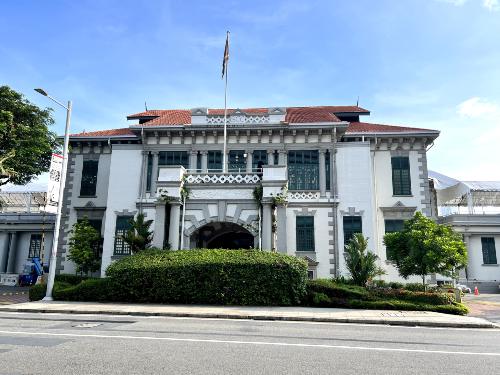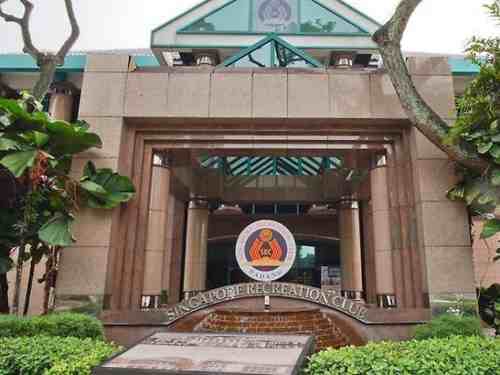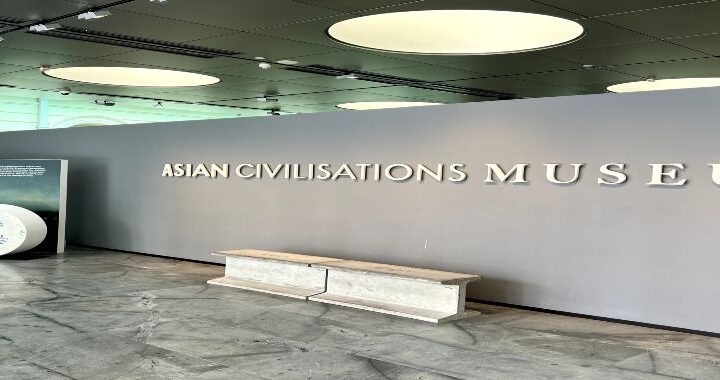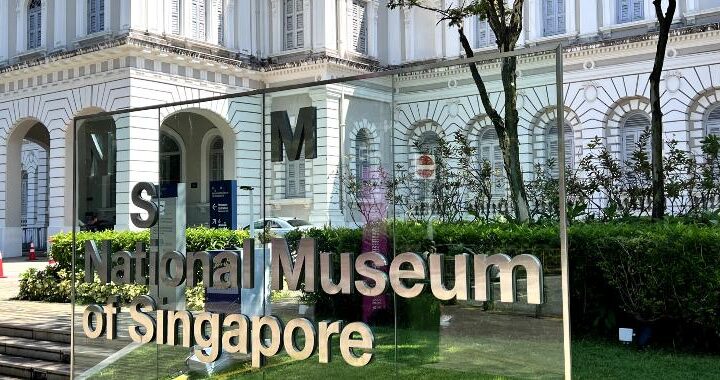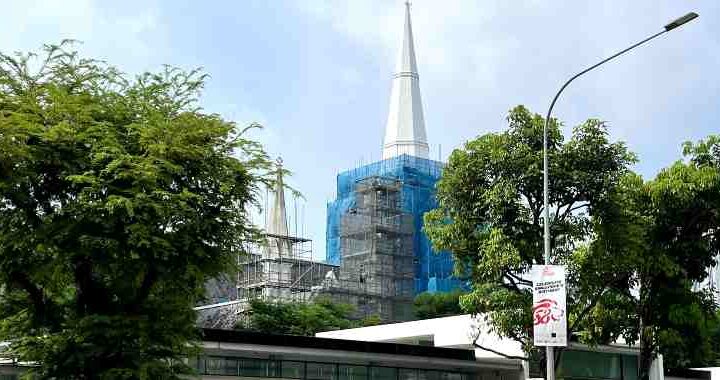The Padang is located in the prime Civic District in Singapore. It is a green field covering 4.3 hectares, equivalent to about six soccer fields. The Padang means ‘field’ in Malay and although it is merely a patch of green turf, it played an integral part in Singapore's history.
Several other iconic and historical landmarks of Singapore are within walking distance of The Padang: The Asian Civilisations Museum, The Arts House, St. Andrew’s Cathedral, National Gallery Singapore, Fort Canning Park, to name a few You will not miss this historical site when you are visiting the civic district.
The Padang has witnessed several historic and important events that have taken place in Singapore over the last two hundred years. Hence, most older Singaporeans will have an intimate relationship with it in some way. It has since been recognized and gazetted as a national monument on 9th August 2022 for its significant role in our history.
Getting to The Padang
The Padang is located in the Downtown Core of the Central Area in Singapore. It is bordered by Connaught Drive, Saint Andrew's Road, and Stamford Road. The Singapore Cricket Club and Singapore Recreation Club sit on either end of the Padang.
Address: 300 Raffles Place, Singapore 048622 (Map).
There are a few ways to get to The Padang.
MRT: The nearest MRT station to The Padang is Esplanade (CC3) station. It is on the Circle Line and North-South Line. You can take either line to get to the station. From there, it is about two minutes walk away.
Public Buses: There are several bus services to reach The Padang, Singapore. The nearest bus stop to The Padang is:
- Esplanade Dr - Aft Esplanade Stn Exit D (02029)
- Raffles Ave - the Esplanade (02061).
The following bus services stop at these bus stops: 106, 166, 174, 80, 961M, 107, 130, 131, 100
Taxis / Ride-Hailing Cars: The Padang is located in an easily accessible location, the easiest ways to reach it are by MRT or public buses. You can also take a taxi or ride-hailing car. It will cost more and there may be heavy traffic along some routes during the weekends.
Tips: Refer to these Singapore travel guides and advisories by Laaasia Travel to help you plan an enjoyable and memorable vacation.
History Of The Padang
Below is a brief history of The Padang, starting from the 14th Century when Sang Nila Utama fled from his enemies in Palembang and landed on the island of Temasek (which is now Singapore). This marks the beginning of its rapid and fascinating transformation to become one of the world's most modern metropolis.
14th Century
The importance of The Padang goes back as far as the early 14th century. According to the Malay Annals, Sang Nila Utama, a Srivijayan prince from Palembang, spotted a strange but magnificent creature at The Padang after landing in Singapore (then called Temasek).
He was told that the creature was a singa (lion). However, this is most probably erroneously as there were no lions in Temasek at that time. Most likely, the creature that he saw was a tiger. Nevertheless, he felt it was a good sign and decided to establish a kingdom here and renamed the place Singapura.
Sang Nila Utama and his descendants ruled over Singapura somewhat unpeacefully as they faced threats from the Majapahit empire and to some extent, the Siamese. Most of the time, they were able to fend off the threats and attacks until 1398 when the fifth and last ruler Parameswara lost the war and had to flee to Malacca to escape from the Majapahits.
After the Majapahit empire took over, Singapura gradually became a sleepy fishing village.
Founding Of Singapore
Singapura and The Padang started to gain prominence after Sir Stamford Raffles and William Farquhar landed in 1819 and managed to secure the area to be part of the Sepoy Lines that housed Indian Troops.
Initially, The Padang was known by many names: The Cantonment, The Plain, and The Esplanade, before settling for The Padang which lasted till this day.
Raffles wanted the north bank of the Singapore River to be used for civic and public purposes and left instructions for William Farquhar, the first Resident of Singapore.
Farquhar did not exactly follow the script and allowed Europeans to build their private residences on the fringe of the Padang. This annoyed Raffles when he came back to Singapore and the duo's relationship deteriorated.
The original eight-foot-tall (2.4 m) Raffles dark bronze statue used to be located at The Padang when it was first unveiled on 27 June 1887 in celebration of the Golden Jubilee of Queen Victoria’s reign.
It sat at The Padang until 1919 when it had to be relocated because it was often unceremoniously hit by flying footballs during games. Also, spectators at The Padang liked to sit at its base while viewing games. Currently, the statue has been relocated close to the Victoria Memorial Hall.
In the 19th century right up to WW2, The Padang was mainly used for recreational and entertainment purposes. These include New Year’s celebrations, dance performances, soccer, and cricket matches. The celebration of the Golden Jubilee of Queen Victoria’s reign was also held there on 27 and 28 June 1887.
Japanese Occupation
During the Japanese Occupation from 1942-45, The Padang served as a parade and ceremonial ground as a display of Japan's imperial power. The Japanese also used it to interrogate European prisoners-of-war and civilians before they were marched to Changi and other detention camps.
Post World War 2
The situation at The Padang turned for the better, albeit briefly, after the Japanese surrender and victory parades were held there.
Later, The Padang started to see confrontations, rallies, and protests as the local population was unhappy with the British capitulation during the Second World War, and The Padang was big enough for big crowds to gather.
There were also riots, including the infamous Maria Hertogh racial riots in 1950. The riots were sparked by a custody battle over the then 13-year-old girl, who was born to a Dutch-Eurasian Roman Catholic family, but raised by a Malay Muslim family during World War II.
The riots lasted for three days and resulted in the deaths of 18 people and the injury of 173 others.
When the People Action Party (PAP) won its first general election in 1959 after winning 43 out of 51 seats, 50,000 supporters turned up at The Padang on 3 June 1959 for its victory rally.
After Singapore merged with Malaya to form Malaysia on 16 September 1963, Lee Kuan Yew also addressed the crowd at The Padang from the City Hall Steps. The proclamation was delivered with emotion and tears: PAP delivered what it promised in the 1959 general election with the merger to achieve independence.
The Padang also bears witness to the appointment of Singapore’s first President, Yusof bin Ishak in 1959. After Singapore gained independence, the site was used regularly for National Day Parade celebrations from 1966-75.
The Padang Post Independent
Unfortunately, the merger with Malaysia did not work out well and Singapore was left to fend for itself as a sovereign state on 9 August 1965.
On 9 August 1966, The Padang witnessed Singapore's first National Day Parade. The choice of The Padang to hold National Day Parades continued annually until 1974 when other venues were used.
Currently, The Padang is only used sparingly for the Singapore National Day celebration - once every five years. The last time the Padang was used to celebrate National Day was in 2019 to celebrate Singapore's bicentennial edition (200 years after Sir Stamford Raffles's founding).
On weekends, The Padang is used for soccer and rugby practices.
Historical Buildings At The Padang
When one mentioned The Padang, the Singapore Cricket Club (SCC) and Singapore Recreation Club (SRC) will come to mind as they are located on the grounds of The Padang. It is not possible to disentangle these two clubs from The Padang as they have a long association with its history.
Singapore Cricket Club
Located at the southern end (near Victoria Theatre and Concert Hall) of The Pandang is Singapore Cricket Club (SCC ). It was first established in 1853 by 28 members, making it one of the oldest social clubs in Singapore.
SCC was initially set up for white European businessmen but later membership included prominent government figures like the Governors of the Straits Settlements.
Membership grew steadily until the two world wars, which led to the club being closed temporarily during WWII, and was used by the Japanese for meetings.
Although it started as a cricket club, it has grown to include other sporting activities like athletics, soccer, rugby, and tennis. These sports are very much at the core of its activities today.
The clubhouse started off humbly in 1884 with just a wooden-hut pavilion before more structures and improvements were made. Today, the clubhouse is modern-looking and offers fine dining and local fare cuisines.
Its sporting facilities include a bowls green, gymnasium, tennis and squash courts, as well as The Padang which was used for field sports. Altogether, it promotes thirteen different field and court sports on its premises, and these include squash, netball, and tennis besides rugby, soccer, cricket, etc…
SCC also hosts the prestigious Singapore Cricket Club International Rugby Sevens annually. The event is one of the premier international club tournaments in Asia, involving teams from around the world.
The trophy for the tournament, the Ablitt Cup, is named after Mr Bernard E Ablitt who was Convenor of the SCC Rugby Section from 1931-2 and President of the club from 1938-9.
Singapore Recreation Club
On the opposite end of SCC is the Singapore Recreation Club (SRC). It is on the northern end (near Tan Kim Seng Fountain) of The Padang. SCC was founded in 1883 by thirty young Eurasian cricketers to promote sports. During its founding, SRC only admitted Eurasian men.
SRC's original location was a building on Waterloo Street, but it was later moved to The Padang after the construction of a simple pavilion in 1885. A second and grander pavilion was constructed and opened in 1905 due to the increasing membership. It was a two-storey building with servants' quarters, billiards, reading, and even a ladies' room.
During the Japanese occupation, SCC was initially used as a registration centre. Those with British and Dutch parentage were marched to camps in Changi from The Padang in front of SRC. Later SRC served as an outpatient hospital for the Japanese during the war.
The current clubhouse was unveiled in 1997 after fundraising activities by its members. Today, SRC has more than 7,000 members and it continues to promote all sorts of sporting, recreational, and social activities.
Visiting The Padang
Although The Padang may just be a big plain field and there is nothing much to see, except when it hosts some sporting activities, it is still worth a trip there for its historical significance. It is centrally located in the Civic District, which is also home to other attractions such as National Gallery Singapore, Fort Canning Park, and St Andrew's Cathedral.
Do check out the sporting calendars and time your visit to coincide with an international sporting event if you are a sports fan.
But, if you are looking for some fun places to visit with your kids, here is a list of 10 family-friendly places to consider.
Other Must-See Attractions & Tours
Besides the Padang, please check out the following attraction, cruise, theme park, and guided tour deals.
- Singapore Flyer - Enjoy A 360-Degree View of the City and Beyond
- Gardens by the Bay - A Horticultural Marvel Not to be Missed
- Singapore Bird Park - An Enchanted Journey Through the Avian World
- S.E.A. Aquarium An Unveiling Oceanic Mysteries
- Universal Studios Singapore - Embark on a Trip of Fantasy and Adventure
- Adventure Cove Waterpark - Where Splashes of Joy Never End
- Mandai Wildlife Reserve - A Fascinating Journey Through the Animal Kingdom
- The Buddha Tooth Relic Temple and Museum - Embark on A Spiritual Discovery
- Chinatown - A Blend of Tradition and Modernity
- Sultan Mosque - A Majestic Symbol of Faith
- Singapore Botanic Gardens - A Marvel of Botany and Horticulture
- West Coast Park - A Leisure Day Out by the Sea
- Singapore River Cruise - A Sail Through History
- Popular Guide Tours - Discover Multi-Faceted Singapore

